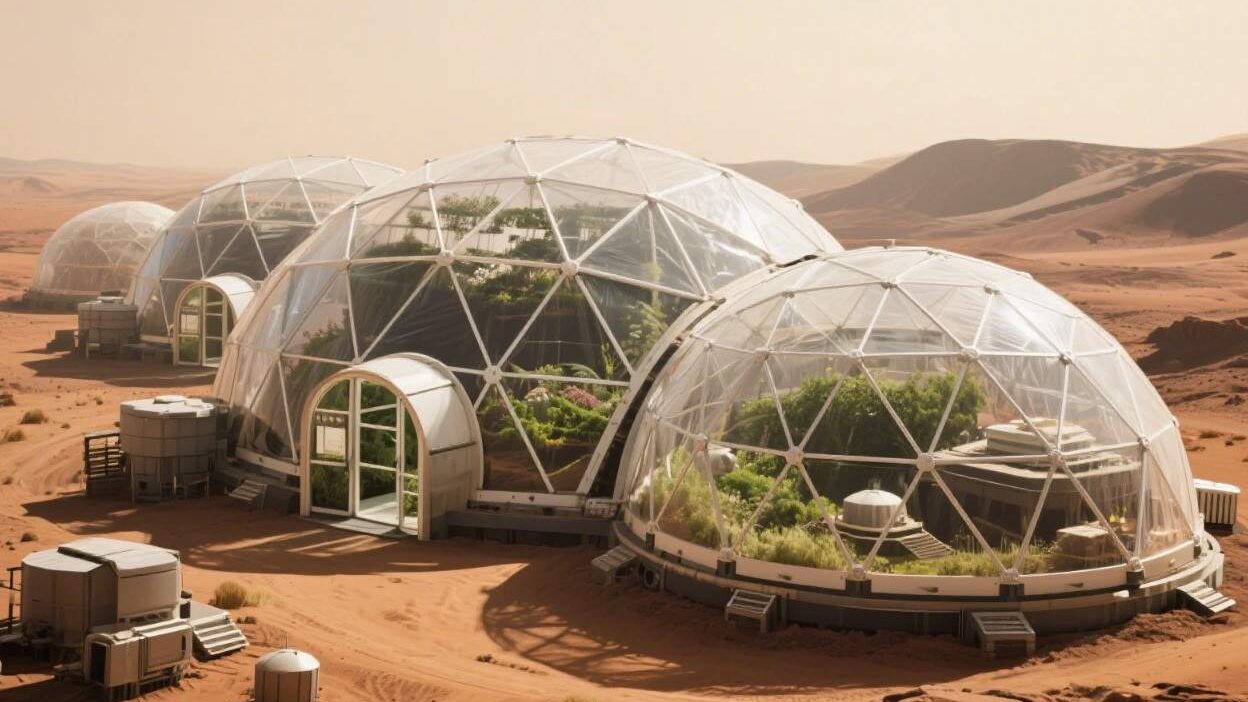Engineering Self-Sustaining Havens in the Martian Wilderness
The Imperative of Closed-Ecosystem Bio-Domes for Mars
Humanity’s ambition to colonize Mars—driven by NASA’s Artemis program, SpaceX’s Starship, and international space agencies—faces a critical bottleneck: sustaining human life beyond Earth. Mars’s harsh environment—thin atmosphere (96% CO₂, 0.1% O₂), extreme temperatures (-140°C to 20°C), radiation (300 mSv/year, 30x Earth’s), and lack of liquid water—renders traditional habitats unsustainable. Closed-ecosystem bio-domes, enclosed environments that replicate Earth’s biosphere, emerge as the linchpin of Mars colonization. These self-contained systems integrate life support, agriculture, waste recycling, and energy production to create habitable oases. This report explores the design, technologies, challenges, and future of closed-ecosystem bio-domes, positioning them as humanity’s blueprint for thriving on the Red Planet.
Closed-Ecosystem Bio-Domes: Definition and Core Components
A closed-ecosystem bio-dome is a sealed, pressurized structure designed to sustain human, plant, and microbial life through controlled interactions of atmosphere, water, soil, and energy. Its core components mirror Earth’s biosphere but are engineered for Martian conditions:
1. Atmospheric Regulation
- Oxygen Production: Photosynthetic organisms (plants, algae, cyanobacteria) convert CO₂ to O₂ via photosynthesis. Synthetic biology enhances this process, engineering microbes to produce O₂ at higher rates.
- CO₂ Scrubbing: Absorbent materials (e.g., zeolites) or chemical reactions (e.g., sodium hydroxide) remove excess CO₂, preventing toxic buildup.
- Pressure and Humidity Control: Automated systems maintain Earth-like pressure (1 atm) and humidity (30–70%) to protect human health and crop viability.
2. Water Cycle Management
- Rainfall Simulation: Aerosolized water vapor condenses on cooled surfaces, mimicking Earth’s hydrological cycle.
- Recycling Systems: Greywater (from sinks, showers) and blackwater (human waste) are treated via bioreactors, where microbes break down organic matter into usable water and nutrients.
- Closed-Loop Irrigation: Water from recycling systems is delivered to crops via drip irrigation, minimizing waste.
3. Food Production
- Controlled Environment Agriculture (CEA): Hydroponics (water-based) and aeroponics (mist-based) systems grow crops without soil, using nutrient-rich solutions. LED lighting optimizes photosynthesis.
- Synthetic Biology Crops: Genetically modified plants (e.g., drought-resistant wheat, high-nutrient potatoes) thrive in low-light, high-CO₂ conditions. Algae and fungi produce protein-rich biomass for animal feed or human consumption.
- Livestock Integration: Insects (mealworms, crickets) and small animals (chickens, fish) are raised for protein, with waste integrated into composting systems.
4. Waste Management
- Composting: Organic waste (plant trimmings, food scraps) is decomposed by worms and microbes into fertilizer.
- Bioremediation: Microbes break down toxic compounds (e.g., perchlorates in Martian soil) into harmless byproducts.
- 3D Printing: Recycled plastics and metals from waste are repurposed into tools, habitats, or replacement parts.
5. Energy Systems
- Solar Power: Thin-film solar panels (resistant to radiation) generate electricity, stored in batteries or fuel cells.
- Nuclear Reactors: Small modular reactors (SMRs) provide baseload power, critical for heating, lighting, and life support during Martian winters (6-month night).
- Thermal Regulation: Insulated domes with phase-change materials (PCMs) store and release heat to stabilize internal temperatures.
Lessons from Earth’s Closed Ecosystems
Earth-based closed ecosystems, such as Biosphere 2 (Arizona, USA) and BIOS-3 (Russia), provide critical insights for Mars bio-domes:
1. Biosphere 2 (1991–1993)
A 3.14-acre sealed habitat, Biosphere 2 hosted 8 humans for 2 years. Key lessons:
- Oxygen Depletion: Microbial decomposition of organic matter consumed O₂ faster than photosynthesis could replenish it, requiring oxygen injections.
- Nutrient Imbalances: Crop yields declined due to poor soil management, highlighting the need for synthetic biology to enhance nutrient cycling.
- Psychological Strain: Conflicts arose from resource scarcity, emphasizing the importance of social dynamics in closed environments.
2. BIOS-3 (1970s–1980s)
A Soviet-era facility, BIOS-3 tested closed-loop systems for 180 days. Innovations included:
- Algal Oxygen Production: Chlorella algae produced 150% of the O₂ needed for 3 cosmonauts.
- Waste Recycling: Human waste was converted into fertilizer using bacteria, achieving 95% water recovery.
These projects underscore the need for robust life support systems, microbial management, and human-centric design.
Technologies Enabling Mars Bio-Domes
Emerging technologies are critical to scaling closed-ecosystem bio-domes for Mars:
1. Advanced Life Support Systems (ALSS)
- Integrated Membrane Systems (IMS): Membranes filter CO₂, water vapor, and contaminants, improving air quality.
- Artificial Photosynthesis: Lab-grown “artificial leaves” use catalysts to split water into O₂ and hydrogen, bypassing biological limitations.
2. Synthetic Biology
- Engineered Microbes: Cyanobacteria modified to produce O₂ at 2x Earth’s rates, or to tolerate Martian radiation.
- CRISPR-Cas9 Crops: Crops like potatoes and tomatoes are genetically edited to thrive in low-light, high-salinity Martian soil.
3. 3D Printing and Modular Design
- On-Site Construction: 3D printers use Martian regolith (mixed with binders) to build dome structures, reducing reliance on Earth supplies.
- Modular Components: Bio-domes are built in interchangeable modules (e.g., agriculture bays, living quarters) for easy expansion.
4. AI and Machine Learning
- Ecosystem Monitoring: AI analyzes sensor data (CO₂ levels, plant health, waste outputs) to predict imbalances and adjust systems.
- Resource Allocation: Machine learning optimizes energy use, crop planting schedules, and waste recycling to maximize efficiency.
Challenges and Risks
Despite progress, closed-ecosystem bio-domes face significant hurdles:
1. Technical Limitations
- Leakage: Maintaining a hermetic seal over decades is challenging; even micro-leaks can disrupt atmospheric balance.
- Energy Density: Solar power is intermittent (14-hour Martian night), requiring large battery banks or compact nuclear reactors.
- Material Durability: Martian regolith is abrasive, and radiation degrades plastics and metals, shortening infrastructure lifespans.
2. Biological Risks
- Contamination: Earth microbes could outcompete Martian life (if any) or mutate into harmful strains.
- Crop Failure: Pests, diseases, or nutrient deficiencies in synthetic soils could devastate food supplies.
3. Human Factors
- Psychological Strain: Confined spaces, social isolation, and monotonous routines increase stress and conflict.
- Cultural Adaptation: Long-term isolation may erode community bonds, requiring intentional design of shared spaces and activities.
Case Studies: Pioneering Closed-Ecosystem Projects
1. NASA’s ECLSS (Environmental Control and Life Support System)
Used on the ISS, ECLSS recycles 90% of water and 70% of O₂. For Mars, NASA is testing a scaled-up version with:
- Sabatier Reactors: Convert CO₂ and H₂ into water and methane (fuel).
- Biomimetic Filters: Algae-based systems enhance O₂ production.
2. SpaceX’s Starship Habitation Module
Starship’s 100-person habitat includes a bio-dome prototype with:
- Vertical Farms: LED-lit towers for leafy greens and strawberries.
- Insect Farms: Mealworms for protein, with waste used in compost.
3. The Mars Society’s FMARS (Flashline Mars Arctic Research Station)
Located in Canada’s Arctic, FMARS simulates Mars conditions. Recent experiments show that:
- Hydroponic Wheat yields 50% of Earth’s output with optimized LED lighting.
- Algae Bioreactors produce O₂ at 1.2x the rate of traditional methods.
Ethical and Philosophical Considerations
Designing Mars bio-domes raises profound ethical questions:
- Planetary Protection: Ensuring bio-domes do not contaminate Mars with Earth microbes, preserving potential indigenous life.
- Equity: Ensuring all colonists—regardless of background—have access to resources, healthcare, and decision-making power.
- Stewardship: Balancing human needs with the preservation of Martian ecosystems, even if they are initially barren.
The Future of Closed-Ecosystem Bio-Domes
The future of Mars colonization hinges on refining closed-ecosystem bio-domes:
- Scalability: Developing mega-domes (10–100 km²) to support thousands of colonists, with self-expanding 3D-printed structures.
- Self-Sufficiency: Achieving 100% closed-loop systems, where all O₂, water, and food are recycled without Earth inputs.
- Integration with Martian Resources: Using Martian regolith for 3D printing, extracting water ice from polar caps, and harnessing geothermal energy.
- Global Collaboration: International agreements (e.g., extending the Artemis Accords) to standardize protocols, share data, and pool resources.
Building a Sustainable Future on Mars
Closed-ecosystem bio-domes are not just technological marvels—they are humanity’s first step toward a self-sustaining presence beyond Earth. By integrating life support, agriculture, and energy systems, these domes will enable colonists to thrive in Mars’s harsh environment. As we refine these technologies and address ethical challenges, closed-ecosystem bio-domes will transform Mars from a hostile frontier into a vibrant, human-centered outpost.
The Red Planet awaits—but first, we must build the habitats that will sustain us.



